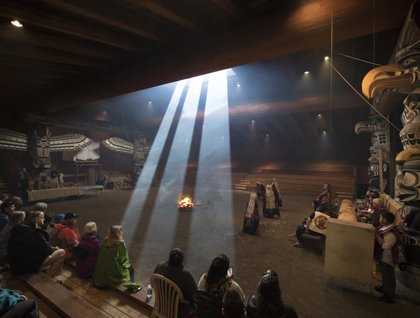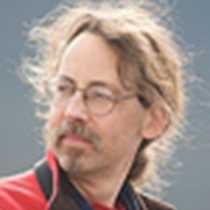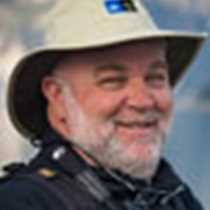We began our day cruising the north end of Johnstone Strait, with the mountains of Vancouver Island looming above us. The strait concentrates tidal currents and this concentrates marine life. At its northern end the strait widens to include open-ocean creatures, and so is a particularly interesting place to explore. And sure enough, the fun began during breakfast. We found Pacific white-sided dolphins. These creatures are almost always found in huge numbers. We found scores of them spread over a wide area. White-sideds are individually beautiful and spectacular en masse. They are engaging creatures, fast moving and apt to bow-ride. What fun to look straight down on speedy beauties! Later in the morning we found a large flock of seabirds fishing a strong current line. Bonaparte’s gulls are dainty and striking, and rose in sudden masses, showing their bright pink feet. Rhinoceros auklets were in breeding plumage, with extravagant “whiskers” and the seasonal “horn” that gives them their name.
Later in the morning we were excited to find a humpback whale. It was impressive to get an idea of the scale of this creature by sensing the ponderous inexorability of its movement. After a few successive breaths the humpback often lifted its tail, a gratifying farewell-for-the-moment. Meanwhile, eagles, loons, and murrelets were flying or paddling all around us.
After lunch we docked at Alert Bay. This small town is the centre of Kwakwaka’wakw ceremonialism. The people here have always been adamant about their traditional ways, despite long and concerted efforts by outsiders at acculturation. Oppression culminated in 1922, when many were arrested for potlatching at nearby Mimcumlis, when much ceremonial regalia was confiscated and taken to museums across Canada. Eventually, this material was returned, and is the core of the collection at U’mista Cultural Centre. We walked to the museum and joined Vivian for a guided tour of the collection.
Then we ascended the hill to the Alert Bay Bighouse. This huge structure, much expanded and rebuilt, was created for potlatching. Every year, dozens of families use the house to host lavish gatherings where they demonstrate their traditional prerogatives, then pay the guests for witnessing the event. Few outsiders ever see the bighouse, but we were invited to see the Tsasatla Dancers, a group of students learning traditional dance. We saw a variety of dances in the order that they would appear at a real potlatch, including the Hamatsa, with dancers acting out possession by cannibal spirit. The Madam dance re-enacts supernatural fliers, and the salmon dance celebrates the return of the economic and ecological foundation of the region. We saw the headdress dance, followed by the appearance of a dloogwe, or magic treasure, in the form of a bookwus, or Wildman of the woods. And at last, many of us joined the performers on the floor for the Umlam, or Fun-dance.
The Northwest Coast is an extraordinarily rich region, both naturally and culturally. Today we experienced both extravagantly.









